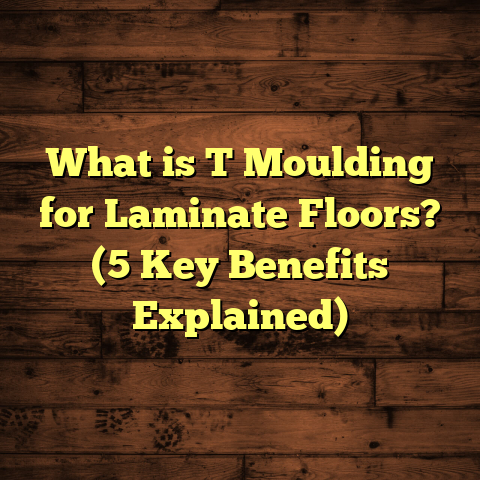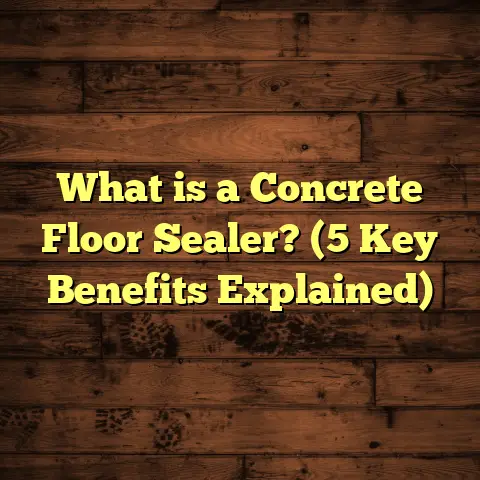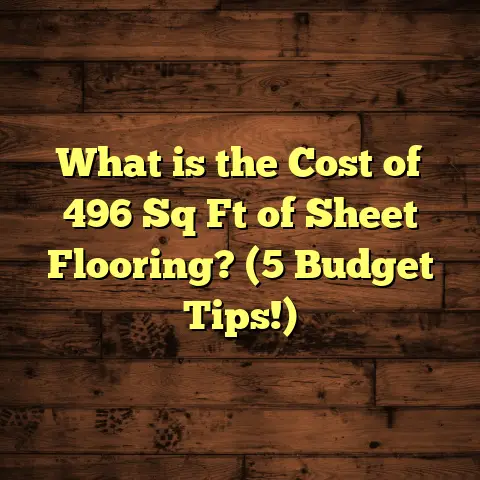What Is Laminate Flooring? (5 Benefits You Can’t Ignore!)
I remember the first time I was handed the task of helping a homeowner choose flooring that would fit their hectic lifestyle and budget. It wasn’t just about picking something that looked nice—it had to handle kids running around, pets scratching, spills, and everyday wear and tear. The options seemed endless: hardwood, tile, carpet, vinyl… and then there was laminate. At first, I wasn’t sure if laminate flooring could really deliver on its promises. Was it just a cheap knockoff? Would it hold up over time? The more I installed and lived with it, the more I realized laminate deserved serious attention. If you’re wondering what laminate flooring really is and why it might just be your best bet, let me share what I’ve learned after years in the business.
What Is Laminate Flooring?
Laminate flooring is often misunderstood. People sometimes think of it as just “fake wood” or a low-quality alternative. But that’s far from the truth. It’s actually a cleverly engineered product built to provide many of the benefits of natural wood or stone while avoiding some of their downsides.
At its core, laminate flooring consists of several layers fused together:
- Wear Layer: This is the clear top coat that protects the surface from scratches, stains, fading, and everyday damage. It’s made from tough melamine resin or aluminum oxide.
- Design Layer: Underneath the wear layer is a high-resolution photographic image that mimics wood grain, stone textures, or other patterns. This layer is what gives laminate its realistic look.
- Core Layer: The heart of the plank, made from high-density fiberboard (HDF) or medium-density fiberboard (MDF). This layer provides strength, stability, and resistance to impact.
- Backing Layer: The bottom layer balances moisture exposure and adds dimensional stability.
Think of it like a sandwich where each layer plays a key role. The wear layer keeps your floor looking fresh despite daily abuse. The design layer tricks the eye with realistic patterns. The core gives the floor its toughness. And the backing protects against moisture from below.
Unlike solid hardwood, laminate doesn’t require sanding or refinishing. It’s designed to be installed as a floating floor—meaning the planks lock together but don’t adhere to the subfloor with glue or nails. This makes installation much faster and often DIY-friendly.
How Does Laminate Look So Real?
When I first saw laminate floors in person, I was surprised at how closely they could resemble natural wood grains or stone tiles. The secret lies in the high-resolution photographic layer combined with embossing techniques that add texture matching the image underneath.
For example, a laminate designed to look like oak will have visible grain patterns you can feel under your fingers. This texture adds to the authenticity and helps disguise minor scratches or dents.
The variety available today is staggering—from rustic barnwood styles to sleek modern planks mimicking exotic hardwoods.
My Experience Installing Laminate Floors
Over the years, I’ve installed laminate flooring in dozens of homes, rental units, offices, and retail spaces. Each project has taught me something new about the material’s strengths and weaknesses.
One memorable project was for a young family with two toddlers and a dog. They wanted wood-look floors without worrying about scratches from toys or claws. We chose a mid-range laminate with a thick wear layer and water-resistant core.
The installation took just two days for their entire 1,200 square foot main floor. No dust from sanding like hardwoods, no long drying times. The family was thrilled that cleanup was simple and that the floor looked great even after months of heavy use.
This project confirmed what I’d seen elsewhere: laminate can be a practical choice for busy households.
Five Benefits of Laminate Flooring You Can’t Ignore
1. Cost-Effectiveness Without Compromise
Budget is almost always a key factor when choosing flooring. Hardwood floors look amazing but often come with sticker shock—especially exotic species or wide-plank styles.
Laminate flooring offers a visually similar look at a fraction of the cost. Depending on quality, laminate typically costs between $1.50 and $5 per square foot for materials alone. Installation adds roughly $2 to $4 per square foot if you hire professionals.
In contrast, hardwood installation can run $8 to $15 per square foot or more.
Here’s a quick cost comparison based on my recent projects:
| Flooring Type | Material Cost (per sq ft) | Installation Cost (per sq ft) | Total Cost Range (per sq ft) |
|---|---|---|---|
| Hardwood | $5 – $10 | $3 – $5 | $8 – $15 |
| Laminate | $1.50 – $5 | $2 – $4 | $3.50 – $9 |
| Vinyl | $2 – $6 | $2 – $4 | $4 – $10 |
This affordability means you can afford a larger area or higher-end style within your budget.
2. Quick and Easy Installation
If you’ve ever watched professionals install hardwood floors, you know it can take several days or even weeks due to precise nailing, sanding, finishing, and drying times.
Laminate floors are much faster to install because of their click-lock design. Planks snap together easily without glue or nails.
When I first tried installing laminate myself on a small project, I was amazed at how quickly the floor came together—about half the time of traditional hardwood.
This ease also means less disruption for homeowners who want to minimize downtime during renovations.
3. Durability That Stands Up to Life
Durability is where laminate shines for me personally. Working in homes with kids and pets has shown me how quickly hardwood floors can show scratches or dents.
Laminate’s wear layer resists surface damage very well. It’s also less prone to fading from sunlight exposure compared to natural wood.
I’ve seen laminates endure heavy foot traffic in commercial spaces too—shops and offices where people walk constantly still have floors looking good after years.
Statistically speaking, modern laminates boast abrasion resistance ratings (AC ratings) from AC3 (residential moderate traffic) up to AC5 (heavy commercial traffic). Choosing an AC4 or AC5 rated laminate guarantees strong wear resistance for most home applications.
4. Minimal Maintenance Needs
Another big plus is how little work laminate floors require after installation. Unlike hardwoods that need periodic refinishing or waxing, laminate only needs regular sweeping and occasional damp mopping.
I always tell clients to avoid soaking floors or using harsh chemicals that could damage seams or finish.
This low-maintenance aspect suits busy families or anyone who doesn’t want to spend hours cleaning floors every week.
5. Versatile Styles and Applications
When I first started in this field years ago, laminates mainly mimicked oak or maple woods for living rooms or bedrooms.
Now? The options are vast:
- Wide plank laminates resembling reclaimed wood
- Stone-look tiles for kitchens and bathrooms
- Waterproof laminates suitable for basements
- Textured finishes that feel like real wood grain
- Exotic woods like walnut or teak patterns
This versatility lets you get creative with your design without sacrificing durability or budget.
Real Case Study: Laminate Flooring in a Multi-Pet Home
One client of mine owns three large dogs—a guaranteed challenge for any flooring type. Their previous hardwood floors had deep scratches within months.
We installed an AC5-rated waterproof laminate with an embossed wood grain finish in their living room and hallway.
After two years, they reported zero visible damage despite daily pet traffic. Cleanup was easy after muddy paws came inside during rainy seasons.
This case proves how laminate can outperform traditional wood in tough environments.
Common Questions I Get About Laminate Flooring
Is Laminate Flooring Waterproof?
Most laminates aren’t fully waterproof but water-resistant to varying degrees depending on brand and core material.
There are now waterproof laminate products designed specifically for kitchens or basements with moisture exposure. These use special cores and sealed edges to prevent water penetration.
If moisture is a big concern (like bathrooms), consider waterproof vinyl planks instead or specialized waterproof laminates.
Can Laminate Flooring Be Installed Over Radiant Heat?
Yes! Many laminates are compatible with radiant heating systems as long as manufacturers’ guidelines are followed on temperature limits.
I’ve installed laminate over radiant heat in several homes without issues but always ensure proper acclimation before installation.
How Long Does Laminate Flooring Last?
With proper care, laminate floors typically last 15-25 years or longer depending on wear levels and quality chosen.
I’ve seen high-end laminates still look great after 20+ years in commercial settings.
Is Laminate Flooring Environmentally Friendly?
Good question! Traditional laminates use wood fiber cores bonded with resins which may emit VOCs (volatile organic compounds).
However, many manufacturers now offer low-VOC laminates made with sustainable forestry practices and formaldehyde-free adhesives.
If eco-friendliness matters to you, ask about certifications like FloorScore or GREENGUARD when shopping.
Tips From My Experience for Choosing Laminate Flooring
- Pick the Right AC Rating: For residential use in living rooms or bedrooms, AC3 is usually fine; kitchens or hallways benefit from AC4; commercial spaces should go AC5.
- Consider Thickness: Thicker planks (8-12 mm) feel more solid underfoot and better mask subfloor imperfections.
- Don’t Skimp on Underlayment: Quality underlayment improves sound insulation and moisture protection.
- Check Warranty Details: Longer warranties often indicate higher quality.
- Match Your Lifestyle: Kids? Pets? Heavy foot traffic? Choose accordingly.
- Get Samples: Compare samples in your home’s lighting before buying large quantities.
- Hire Professionals if Unsure: While DIY friendly, professional installation avoids mistakes like poor acclimation or uneven subfloors causing problems later on.
Comparing Laminate Flooring With Other Popular Options
To give perspective based on my years working across many projects:
Hardwood vs Laminate
Hardwood has unmatched natural beauty and can be refinished multiple times but costs much more upfront and requires maintenance like polishing and refinishing.
Laminate offers similar visuals at lower cost with better scratch resistance but can’t be sanded or refinished once worn out.
Vinyl vs Laminate
Vinyl planks are often more waterproof than laminate making them better for bathrooms/basements. Vinyl also tends to feel softer underfoot but may not have as authentic wood textures as high-end laminates.
Laminate tends to look more realistic but isn’t fully waterproof unless specially rated products are chosen.
Carpet vs Laminate
Carpet adds warmth underfoot but stains easily and traps allergens. Laminate is easier to clean and better for allergy sufferers while providing a harder surface ideal for rolling chairs or pets.
Tile vs Laminate
Tile excels in wet areas due to waterproof nature but feels cold and hard underfoot; installation is slower/complex; grout needs upkeep.
Laminate is warmer feeling and faster to install but not suited for very wet zones unless waterproof versions are used.
Addressing Common Laminate Flooring Problems From My Work
Problem: Seams Separating Over Time
Cause: Improper acclimation before installation or uneven subfloor can cause planks to expand/contract excessively leading to gaps.
Fix: Allow flooring material to sit in install room 48+ hours before laying down; ensure subfloor flatness within 3/16 inch over 10 feet; leave proper expansion gaps around perimeter walls.
Problem: Warping/Swelling
Cause: Excess moisture exposure from spills left too long or flooding; poor underlayment moisture barrier.
Fix: Clean spills immediately; install moisture barriers when needed; consider waterproof laminate if moisture risk is high.
Problem: Scratches/Dents Showing Quickly
Cause: Low-quality wear layer; heavy furniture dragged without pads; pets’ claws untrimmed.
Fix: Invest in higher grade laminate with thick wear layers; use furniture pads; maintain pet nails regularly; place rugs in high traffic areas.
A Deeper Look at Cost Breakdown From My Projects
When budgeting for laminate flooring, here’s what I typically see:
- Material Costs: $1.50-$5 per sq ft depending on brand/style.
- Underlayment: Usually included but can add $0.20-$0.50 per sq ft extra.
- Installation Labor: $2-$4 per sq ft by professionals.
- Additional Supplies: Transition strips, quarter rounds ~$100-$300 depending on project size.
- Waste Factor: Usually add 5-10% extra material for cuts/spills/waste.
For an average 1,000 sq ft space:
| Item | Estimated Cost Range |
|---|---|
| Materials | $1,500 – $5,000 |
| Underlayment | Included/extra up to $300 |
| Installation Labor | $2,000 – $4,000 |
| Supplies | $100 – $300 |
| Waste Allowance | Included in materials |
| Total | $3,600 – $9,600 |
You can clearly see how quality choice impacts total price significantly.
Why So Many Homeowners Are Choosing Laminate Today
From my work across various projects—from modest apartments to large family homes—laminate continues gaining popularity because it offers:
- Style variety
- Budget-friendly pricing
- Long-lasting durability
- Fast installation
- Easy maintenance
I’ve had clients return years later still happy with their laminate floors—some telling me they prefer it over real hardwood because it handles life’s bumps better without panic over every scratch or spill.
Wrapping Up My Thoughts
If you’re thinking about new flooring but want something affordable yet stylish that won’t require constant care or cost a fortune—laminate flooring should definitely be on your shortlist.
Ask yourself:
- How much traffic will this floor see?
- Do I have kids/pets?
- What’s my budget?
- Do I want a DIY project?
- Is moisture exposure an issue?
Answering these helped me guide clients toward successful choices again and again.
Feel free to reach out if you want advice tailored specifically for your flooring needs—I’m always happy to share what I’ve learned through hands-on experience helping homeowners create beautiful spaces they love walking on every day!





